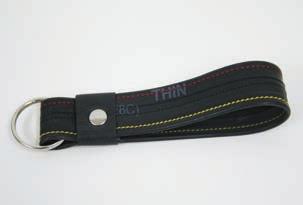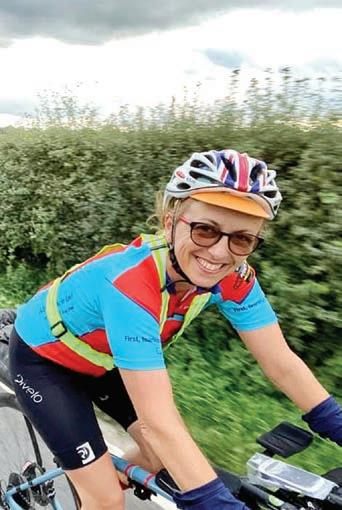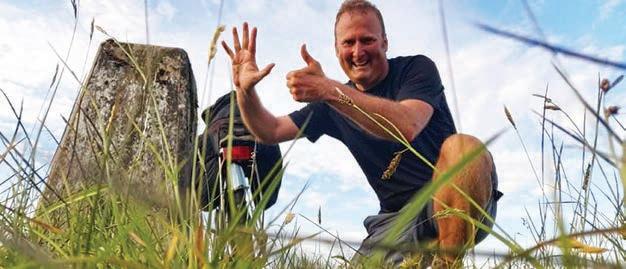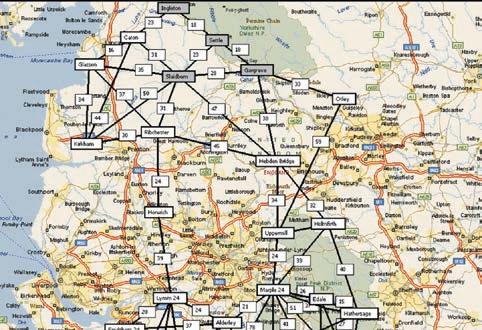
16 minute read
Cycling shorts
by Audax UK
CYCLING
SHORTS Cycling Shorts is a platform for your news, views and opinions on anything bikerelated. How did it feel getting back on the road after the months of lockdown? Did you spend your days in isolation plotting and planning new routes? Or did you overdo it on the cake and biscuits? Maybe you’ve got something else to get off your chest. We’re keen to hear any of your biking tales, old or new. Drop us an email with the details. We’re looking for all types of story from Audax riders (up to 200 words), with a picture of yourself, too. Contact gedlennox@me.com.
Advertisement
Taxpayer to fund e-bike boom?
The government is reportedly considering introducing a scheme to promote the sale and use of electric bikes as part of a more general campaign to improve the nation’s fitness.
At the end of July this year, roads minister Jesse Norman indicated that a subsidy was being considered to encourage older and less fit people who may be unsure about getting back into the saddle, to buy an e-bike.
The vehicles, which can cost anything between £600 and £3,000, can be powered by a small electric motor within the bike’s frame, as well as propelled by pedals. The suggestion is that they will be included in the government’s £2 billion proposal to promote cycle use generally.
So far there are no details about the e-bike subsidy, though if it similar to the scheme for electric cars, the taxpayer may pick up the bill for up to a third of the cost.
The announcement came on the same day that the government launched a scheme offering bicycle repair vouchers. The website crashed within minutes of the scheme’s midnight on 29 July launch, according to news reports.
While demand was expected to be high, the popularity of the £50 repair voucher scheme, 50,000 of which were offered on a first-come, first-served basis, took the government by surprise. CS
OCD claims
This has not been the best year for Audax rides, but if you have been out on your own, cycling in the hills, you may have some cols to claim.
So, as you are reading this, now is a good time to review, and submit your claim via the AUK website.
A Lockdown SR Back in March a pessimistic John Irwin, fearing a total lockdown, rented a treadmill and exercise bike before the hire company shut up shop. Roll forward to early April and, although he was clocking up the kilometres on the treadmill, the bike had yet to see any significant usage. Realising it was only a matter of time before this would start to draw comments from his family he decided to do something about it…
My first few 25km efforts were hot and boring but, with an industrial fan and streaming music, it was altogether different. I started to appreciate the efficiency of the bike as a means of covering distances I could only dream of outdoors. I started to think about what my standard six hours per 100km with stops might feel like and then if I could do a 200 on it? If I could do a 200, could I do a 300, and if I’d done a 200 and a 300, could I go the whole hog and do a 400 and 600 to complete the set? … once the idea was in my head, the Lockdown SR was on!
I was up early on the morning of 26 April for the first leg. My strategy, thinking of longer rides ahead, allowed two hours including stops every 50km with longer two-hour breaks after each 100km. This pattern served me well throughout the series. I even had time, on the longest rides, for four-hour sleeps each night which was a novelty and a luxury for someone who usually rides in fear of missing the cut! That said, plenty of time was lost from faffing at virtual controls but at least there weren’t any queues.
Even though cycling indoors meant no headwinds, rain or hills, I suffered just the same, particularly on the longer two rides which were as tough as anything I’ve experienced outdoors – riding solo and staring at the same wall for 1500km was hard enough, without catching sight of the occasional ‘wall monster’ lurking in the corner of my eye.
Physically I’d seriously underestimated just how much time is spent freewheeling in the real world, and this lack of punctuation became more prominent the further I rode – evidenced by the penultimate 50km becoming two 25km legs and the final 50km being ridden over four 12.5km legs!
Although I met the challenge, and successfully completed my Lockdown SR, it was probably a one-off, driven by a unique set of circumstances I’m hoping not to encounter again. And, of course, I prefer to ride outdoors and have my rides officially validated.
Starting, finishing and remaining at home throughout provided me with easy access to my domestiques, both of whom lasted the event, so thank you, long-suffering wife and daughter.
CS
The Crafty Charlotte upcycles fancy furlough fashion
Like many an Audaxer, ceramic artist Charlotte Stockley found herself with time on her hands during the lockdown furlough – and turned her attention to a pile of old inner tubes.
“Being furloughed from work meant that I finally had time to concentrate on all those crafty ideas on my to-do list,” she says.
“While I try to patch as many punctured inner tubes as possible, some are inevitably irreparable. Rather than throw the old tubes in the bin, I’m now upcycling them into various items, such as keyrings, dog leads, bookmarks and Christmas decorations.
More products are in the design stage. Charlotte is pictured here with one of her keyrings, which was stitched on a sewing machine using different coloured thread, then riveted into place.
Charlotte, who lives in Surbiton, Surrey, cycles every day to her studio in Kingston-on-Thames. She rides for Kingston Wheelers and regularly takes part in Audaxes and other long-distance events. In 2017 she cycled a solo LEJOG over 11 days, and also had a couple of memorable years at the Tour of Flanders sportive with fellow members of Kingston Wheelers.
You can see other examples of her art at https://folksy.com/shops/CharlotteStockley.

Charlotte Stockley

John Irwin
CS
Firm’s bike scheme benefits local campaigners
Small businesses across the country are coming up with creative ways to promote cycling as a clean alternative to other forms of transport.
One example is Aquabio Ltd, a Worcester-based company which is actively encouraging employees not only to come to work on their bikes, but to use them to travel to other sites or to meetings during the day.
And Bike Worcester, a group of cycling enthusiasts whose aim is to turn their city into a bike-friendly environment, is set to benefit financially from the Aquabio scheme.
The company, which specialises in industrial water re-use and anaerobic digestion, will log the distances covered by employees in the course of their work, and will donate 2.5p for every kilometre cycled to Bike Worcester.
Terry McCarthy, Aquabio’s MD said: “The scheme has transformed the way we think about transport. Using a bike to travel to the office, to construction sites or to meetings is now seen as a normal activity, and we’re seeing our team then using bikes more in their personal lives.” Audax UK member, Andy Rich isn’t a fan of turbo-trainer sessions. When he used to compete in triathlons he says he would begrudgingly do some sets when the roads were icy, or if he was pushed for time. “I would never have considered cycling 240 miles on one,” he says.
But when he heard of Scottish distance-rider Mark Beaumont’s plan to ride “Around the World in One Day” to raise funds for the NHS during lockdown, “something clicked,” he says.
“It was the challenge I needed. It was achievable, but it was going to be hard work.”
A total of 79 riders around the country joined in, each completing 240 miles, and being sponsored by the mile… without a single rider leaving
“Fourteen hours later I finished my ride – very tired but with time to spare. I’d raised £750 and eaten my weight in pasta. Would I do it again? I seriously doubt it.”
Mark Beaumont’s Around the World in One Day challenge raised a total of £231,000 for the NHS.
Code to favour cyclists Major changes to the Highway Code, which will have a direct impact on Britain’s cyclists, are being considered by the Department of Transport.
Since its introduction in 1931, the Code has sought to establish a common set of rules for those using the country’s highways. But the grey areas covering priorities applying to different road users – motorists, pedestrians and cyclists – have been the cause of much argument.
In July this year the government announced the preliminary results of a review of the document, which aims to provide clarity on a number of points.
The review will suggest putting vulnerable road users at the top of a new “hierarchy”. This would include giving those walking or cycling priority over motor vehicles when turning left on to side roads.
There will also be new rules regarding giving adequate space for vehicles overtaking cyclists, as well as clarifying the position of cyclists riding two abreast.
Under the proposed new rules, pedestrians, in particular children, older adults and disabled people would be at the top of a road users’ hierarchy, followed by cyclists, horse riders and motor cyclists.
A Cycling UK spokesman, welcoming the moves, said: “It won’t remove the need for all road users to behave responsibly, or give priority to pedestrians and cyclists in every situation, but it will ensure that their needs are considered first.”
The Highway Code currently contains nothing explicit about motorists turning across a cyclist’s path at a junction. Under the new guidelines this action will be deemed illegitimate.
New overtaking rules will state that motorists should give cyclists a 1.5 metre berth if travelling at under 30mph. That width will increase to two metres at higher speeds, with larger vehicles required to give two metres at all times. Cyclists will also be unequivocally allowed to filter through slow-moving or stationary vehicles.
One of the biggest causes of conflict between cyclists and motorists – whether or not to ride two abreast – will also be clarified in favour of the cyclist. The code will clearly state that riders are no longer required to ride in single file.
There could also be new advice to encourage motorists to look before opening car doors into the path of cyclists – a common cause of accidents.
Cycling UK, an independent organisation which has championed the cause of cyclists for 130 years, says the proposals will go a long way to making our roads safer, though it believes the main aim should be to create separate cycle lanes on all roads. CS
Marcia Roberts
CS
PAUL JENNINGS PICTURE

Super mum aims to set new LEJOGLE record
As we go to press, Marcia Roberts, a super-cyclist mum in her fifties, is attempting to set a Guinness world record for a Lands End-to-John O’ Groats-and-back ride – in just 8.5 days.
Marcia, who is riding in aid of the mental health charity, Solent Mind, is on the road and in the eye of storm Francis, a particularly fierce summer storm with gusts of 50mph. We plan to report on the full story of her epic attempt in the next edition of Arrivée.
She also hopes to complete a blog during the ride, which started on 23 August, and you read about her ride on her Facebook group. You can also find details of how to sponsor her
Virtual globe-riders
home.
The riders set off – together, but alone – at 4am on 14 May, with the aim of completing the ride by 8pm on the same day.
“It wasn’t lonely as we were all linked up via Zoom, with guest speakers cycling along with us while telling stories about epic adventures they’d completed,” says Andy.
via Just Giving.
John Irwin

CYCLING SHORTS2

Don’t forget the fun
Real life often gets in the way of cycling – and many readers will empathise with Mike Wallis, an Audax member for 27 years who freely admits that work and domestic life has kept him from the saddle for many years.
But a recent biking expedition with his children reaffirmed his passion for cycling – not just for the rigorous long-distance challenges, the honours and badges, but just the sheer fun of riding one’s bike.
Mike, a 47 year old PE teacher who has worked in Malaysia, London, Egypt, Togo, Lancashire, Qatar and Scotland where he now lives, has been an Audax member since 1993.
“Back then I was cycling for Derby Mercury and hanging on the back wheel of the infamous Mick Potts, Graham Moult, Simon Pedley, Keith Mayfield, David Howes, David Messenger and Jeff Bowler to name a few,” he says.
“The bike was being used very regularly, and I was rushing around all over the place. But life threw up some challenges and cycling took a back seat. For many a year I hardly rode my bike at all.
Nevertheless, Mike was tempted back on the bike this year – for an 11 hour jaunt with two of his children, Ronnie and Shaun, both aged 14, around the “rough stuff” on the Isle of Bute. And this excursion turned out to be one of his most memorable days out on a bike.
“I decided to take advantage of the long Scottish
Mikw Wallace
summer days,” he says. “Around the Isle of Bute are nine trig points – small stone pillars on summits, used for surveying purposes. With the children not in school, I thought that the ride might inspire them to embrace the outdoors and ensure they got to breathe some fresh air.
“The ascents to the top of each trig meant carrying or pushing the bikes, and it brought back memories of watching slideshows with my parents, Brian and Susan, when I was young. These slides showed my own mum and dad doing lots of rough stuff. The slides also included pictures of my grandad, James Wallis, on top of Scafell Pike with his bike in 1929.
Phil’s mapping system is way ahead
What happens when you combine some lockdown spare time with a bit of computer wizardry? If you’re Phil Whitehurst, you come up with a new, interactive mapping device allowing cyclists to digitally find the shortest route between two points anywhere in the country.
In 2018 Hertfordshire-based Phil, an IT specialist who rides for Four Corners Audax, had worked on a project to identify all the Audax UK permanent controls and their locations, resulting in the creation of an interactive permanents map which is currently located at https://perms.audax. uk.
But during lockdown he took his research further. “I was doing some work to make it easier and quicker to either correct existing perm map data or create the map data for new perms,” he says.
The eureka moment came when Phil realised that with the control location data of every permanent, he had the basis for a modern online Audax mesh map.
“We had the locations of controls that will have been chosen with the same criteria in mind as those in the original mesh,” he says. “So the question was, how to build on that data to produce an interactive online mesh.
“I could just stick with a mesh consisting of the existing known control sequences for each permanent. But that could lead to odd routing where the controls of two permanents come very close geographically but don’t overlap.
“I came up with the following rules for the mesh: Each permanent control should be linked to its nearest neighbours; the output should be the list of controls, and for each control a list of the nearest controls that it has been linked to; and for each pair of linked controls, calculate the minimum distance between them.
“For parts one and two I turned to Delaunay 3D triangulation. This divided the map into a series of non-overlapping triangles, with the control locations forming the vertices of each triangle – the edges of the triangles being the routes to take.
“I viewed the result on a map to see that the mesh had the properties I was after. It did. The controls were only directly linked to their nearest neighbours, and the mesh was nice and uniform. There were a few anomalies, for instance where controls across the Bristol Channel were linked, but I edited these out, so the mesh crossed via the nearest controls to the bridges you can cycle on.
Phil wanted to present a map of the UK showing all the permanent controls. A user would then be able to click on any two or more controls in the country, and the map would then calculate the shortest route between them via the other controls.
“Once I understood that the data I’d generated could be transformed into a weighted graph, it became easy,” he says. “Shortest routes through weighted graphs are a well-studied mathematical problem. I turned to Dijkstra’s algorithm, which is both fast and compact – GPS and Sat Nav use a variation of this algorithm to calculate routes. “It’s still a work in progress, but I hope to see it hosted on the Audax UK website in the near future, as a tool to plan DIYs and long-distance routes, via known control points. The modern mesh doesn’t know about roads, just the minimum distance between neighbouring controls – you’d have to work out your exact route yourself. But it should give you a pretty good start.” Phil has been an Audaxer since 2010, and has ridden LEL, Mille Cymru, PBP, WAWA and the West Highlands among others.
Phil Whitehurst











